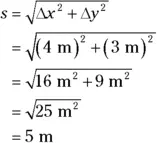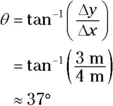
The change in the y location is

If you’re more interested in figuring out the magnitude (size) of the displacement than in the changes in the x and y locations of the golf ball, that’s a different story. The question now becomes: How far is the golf ball from its starting point at the center of the graph?
 Using the distance formula — which is just the Pythagorean theorem solved for the hypotenuse — you can find the magnitude of the displacement of the golf ball, which is the distance it travels from start to finish. The Pythagorean theorem states that the sum of the squares of the legs of a right triangle
Using the distance formula — which is just the Pythagorean theorem solved for the hypotenuse — you can find the magnitude of the displacement of the golf ball, which is the distance it travels from start to finish. The Pythagorean theorem states that the sum of the squares of the legs of a right triangle  is equal to the square on the hypotenuse
is equal to the square on the hypotenuse  . Here, the legs of the triangle are
. Here, the legs of the triangle are  and
and  , and the hypotenuse is s . Here’s how to work the equation:
, and the hypotenuse is s . Here’s how to work the equation:

So in this case, the magnitude of the ball’s displacement is exactly 5 meters.
 You can find the direction of an object’s movement from the values of
You can find the direction of an object’s movement from the values of  and
and  . Because these are just the legs of a right triangle, you can use basic trigonometry to find the angle of the ball’s displacement from the x -axis. The tangent of this angle is simply given by
. Because these are just the legs of a right triangle, you can use basic trigonometry to find the angle of the ball’s displacement from the x -axis. The tangent of this angle is simply given by

Therefore, the angle itself is just the inverse tangent of that:

The ball (refer to Figure 3-2) has moved at an angle of 37° from the x -axis.
Speed Specifics: What Is Speed, Anyway?
There’s more to the story of motion than just the actual movement. When displacement takes place, it happens in a certain amount of time. You may already know that speed is distance traveled per a certain amount of time:

For example, if you travel distance s in a time t , your speed, v , is

 The variable v really stands for velocity, but true velocity also has a direction associated with it, whereas speed does not. For that reason, velocity is a vector (you usually see the velocity vector represented as vor
The variable v really stands for velocity, but true velocity also has a direction associated with it, whereas speed does not. For that reason, velocity is a vector (you usually see the velocity vector represented as vor  . Vectors have both a magnitude (size) and a direction, so with velocity, you know not only how fast you’re going but also in what direction. Speed is only a magnitude (if you have a certain velocity vector, in fact, the speed is the magnitude of that vector), so you see it represented by the term v (not in bold). You can read more about velocity and displacement as vectors in Chapter 4.
. Vectors have both a magnitude (size) and a direction, so with velocity, you know not only how fast you’re going but also in what direction. Speed is only a magnitude (if you have a certain velocity vector, in fact, the speed is the magnitude of that vector), so you see it represented by the term v (not in bold). You can read more about velocity and displacement as vectors in Chapter 4.
 Just as you can measure displacement, you can measure the difference in time from the beginning to the end of the motion, and you usually see it written like this:
Just as you can measure displacement, you can measure the difference in time from the beginning to the end of the motion, and you usually see it written like this:  . Technically speaking (physicists love to speak technically), velocity is the change in position (displacement) divided by the change in time, so you can also represent it like this, if, say, you’re moving along the x -axis:
. Technically speaking (physicists love to speak technically), velocity is the change in position (displacement) divided by the change in time, so you can also represent it like this, if, say, you’re moving along the x -axis:

Speed can take many forms, which you find out about in the following sections.
Reading the speedometer: Instantaneous speed
You already have an idea of what speed is; it’s what you measure on your car’s speedometer, right? When you’re tooling along, all you have to do to see your speed is look down at the speedometer. There you have it: 75 miles per hour. Hmm, better slow it down a little — 65 miles per hour now. You’re looking at your speed at this particular moment. In other words, you see your instantaneous speed .
 Instantaneous speed is an important term in understanding the physics of speed, so keep it in mind. If you’re going 65 mph right now, that’s your instantaneous speed. If you accelerate to 75 mph, that becomes your instantaneous speed. Instantaneous speed is your speed at a particular instant of time. Two seconds from now, your instantaneous speed may be totally different.
Instantaneous speed is an important term in understanding the physics of speed, so keep it in mind. If you’re going 65 mph right now, that’s your instantaneous speed. If you accelerate to 75 mph, that becomes your instantaneous speed. Instantaneous speed is your speed at a particular instant of time. Two seconds from now, your instantaneous speed may be totally different.
Staying steady: Uniform speed
What if you keep driving 65 miles per hour forever? You achieve uniform speed in physics (also called constant speed ). Uniform motion is the simplest speed variation to describe, because it never changes.
Uniform speed may be possible in the western portion of the United States, where the roads stay in straight lines for a long time and you don’t have to change your speed. But uniform speed is also possible when you drive around a circle, too. Imagine driving around a racetrack; your velocity would change (because of the constantly changing direction), but your speed could remain constant as long as you keep your gas pedal pressed down the same amount. We discuss uniform circular motion in Chapter 7, but in this chapter, we stick to motion in straight lines.
Читать дальше



 Using the distance formula — which is just the Pythagorean theorem solved for the hypotenuse — you can find the magnitude of the displacement of the golf ball, which is the distance it travels from start to finish. The Pythagorean theorem states that the sum of the squares of the legs of a right triangle
Using the distance formula — which is just the Pythagorean theorem solved for the hypotenuse — you can find the magnitude of the displacement of the golf ball, which is the distance it travels from start to finish. The Pythagorean theorem states that the sum of the squares of the legs of a right triangle  is equal to the square on the hypotenuse
is equal to the square on the hypotenuse  . Here, the legs of the triangle are
. Here, the legs of the triangle are  and
and  , and the hypotenuse is s . Here’s how to work the equation:
, and the hypotenuse is s . Here’s how to work the equation:
 and
and  . Because these are just the legs of a right triangle, you can use basic trigonometry to find the angle of the ball’s displacement from the x -axis. The tangent of this angle is simply given by
. Because these are just the legs of a right triangle, you can use basic trigonometry to find the angle of the ball’s displacement from the x -axis. The tangent of this angle is simply given by



 . Vectors have both a magnitude (size) and a direction, so with velocity, you know not only how fast you’re going but also in what direction. Speed is only a magnitude (if you have a certain velocity vector, in fact, the speed is the magnitude of that vector), so you see it represented by the term v (not in bold). You can read more about velocity and displacement as vectors in Chapter 4.
. Vectors have both a magnitude (size) and a direction, so with velocity, you know not only how fast you’re going but also in what direction. Speed is only a magnitude (if you have a certain velocity vector, in fact, the speed is the magnitude of that vector), so you see it represented by the term v (not in bold). You can read more about velocity and displacement as vectors in Chapter 4. . Technically speaking (physicists love to speak technically), velocity is the change in position (displacement) divided by the change in time, so you can also represent it like this, if, say, you’re moving along the x -axis:
. Technically speaking (physicists love to speak technically), velocity is the change in position (displacement) divided by the change in time, so you can also represent it like this, if, say, you’re moving along the x -axis:











